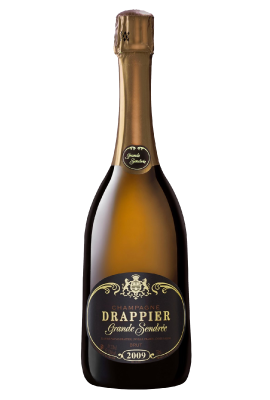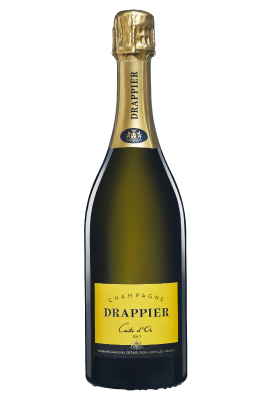Champagne Drappier to achieve a zero carbon footprint
Drappier, a family-run, Aube-based grower and négociant Champagne producer has a very particular character that makes it something of an outlier among its rivals, but also a highly successful business.
And, according to Charline Drappier, the 29-year-old daughter of Michel Drappier (who heads up the house), 2019 was “very good” in terms of sales, with demand up both in the domestic market and exports, even in areas of falling Champagne demand.
Let's explore the reasons in the blog below:

Champagne Drappier to achieve a zero carbon footprint
As of January 2016, Champagne Drappier is the first Champagne House in the World to have reduced their carbon emissions to a net-zero carbon footprint
Invest in sustainable energies
For the past ten years, Drappier has been dedicated to sourcing sustainable energies. To date, 45% of the electricity used by the House is produced by solar panels and, by 2017, that number will increase to 75%. Plans to aggressively reduce fuel consumption to a minimum over the next 5 years have begun. Cellars avoid air conditioning by utilizing a free cooling system, while isolated air conditioning is strategically used throughout the property.
Their fleet of electric vehicles (electric tractors and goods vehicles) allows them to reduce fossil fuel consumption, and electric charging points (generic and Tesla) allow visitors and staff to benefit from the energy produced through our systems.
Champagne Drappier has also started to reduce its carbon footprint by contracting a wind turbine company in India to continue Michel Drappier's vision for his Champagne house. “Investing in a sustainable project in India is our way of expressing gratitude to this small, but dynamic, market for Champagne,” says Michel Drappier, winemaker and CEO of Champagne Drappier.
Recycle everything that can be recycled
The new shape of the Drappier bottle, designed by Michel Drappier, is now 15% lighter than a traditional champagne bottle.
They recycle an array of materials; from bottles to the racks they use for riddling. Each bottle enjoyed at the estate is given a second life, transformed into a high-quality, vegetable wax candle, and presented in a special gift box they call Incandescence.

Near the Cornellier vineyard, architecture students are given free rein to recycle our wine racks and used wine barrels. The local landscape is now dotted with small vineyard huts, which are similar to those used at the time of our ancestors. Passing visitors can step inside and enjoy a tasting experience in the heart of nature.
Become a real farmer
On the estate, they also tend a vegetable garden, look after a henhouse, and manage an orchard following the principles of permaculture.
Their early commitment to ensuring a global ecological approach was recognized in 2016 with the certification of our estate as “Carbon Neutral”. This also meant that Champagne Drappier obtained the following awards:
Michel Drappier, Green Personality of the Year
The Drinks Business – 2017
Prix de l’innovation
La Revue du Vin de France – 2019
Trophée Champenois de la démarche éco-responsable
Bulles & Millésimes – 2018

Farming methods
The Drappier Champagne House team takes care of over 110 hectares of vineyard, of which 60 are privately owned, 17 have been certified organic since 2017, and a further 10 are in transition towards this certification. The whole vineyard is cultivated using sustainable viticulture practices.
They don’t use any herbicides, and they respect the life in the soil with our gentle farming practices: manual weeding (using a hoe), partial grass coverage, horse-drawn plowing, and fallow land. They, therefore, encourage both biodiversity and healthy growth for our grapes. We also cultivate all seven grape varieties found in the Champagne region and therefore help to preserve minority grape varieties, such as Fromenteau, Arbane, Petit Meslier, and Blanc Vrai.
On the estate, Antoine Drappier, the youngest of the family, takes good care of his horses. He uses one, in particular, to work on the land. This precise farming technique means less soil compaction and therefore less erosion.

Recognize on labels
.png)
When buying Champagne Drappier's products, you can see a line on its label that this champagne is made with the sustainable method and an organic one.
Champagne Drappier products are available at WeWine stores nationwide. Visit our stores directly or call 1900 636 749 for best support and quick order with free delivery service.
Source: Champagne Drappier
Recommendation from WeWine 
Related posts
-
What exactly is Biodynamic Wine? Biodynamic wine is great and somewhat odd.
-
Less powerful hangovers, fewer chemicals, and kinder to the environment – no wonder drinking organic wine is becoming a trend.
-
On wine labels, we normally see "contain/no sulphites". What is sulphites? And are sulphites wines good or bad to us?
-
It’s completely logical to think that all wine must surely be vegan. It is, after all, a drink that’s made from pressing and fermenting grapes! While the wine itself is completely fruit-based, it’s the production techniques used in the winery that can turn a vegan-friendly blend into one that vegans would want to avoid.
-
Organic wine has been on the market since the 80s, but at that time the quality was not appreciated. Later, the wineries adjusted the way of making wine and organic wine became one of the trendy beverages in 2009 - According to a survey by the American Restaurant Association.
Copyright © 2020 by WeWine
You must be over 18 to consume alcohol | Sitemap







![[Organic to Vegan] Is Sulphites in wines bad?](https://wewine.vn/datafiles/thumb_1615871305_Sulphites-trong-ruou-co-xau-khong-WeWine.jpg)




